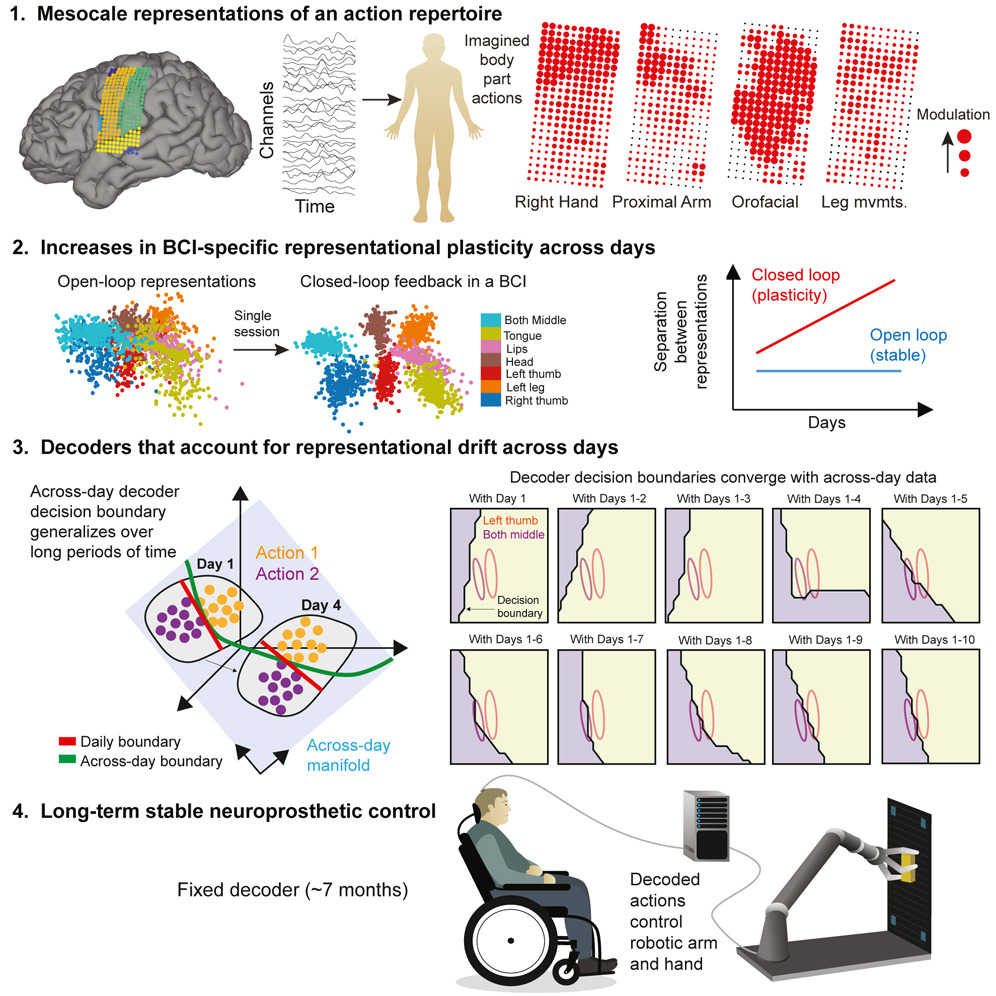New breakthrough in brain-computer interface!
Cell: Paralyzed man uses "thoughts" to control a robotic arm for seven months without any obstacles!
Imagine being able to control a robotic arm to grab, move, and put down objects just by "thinking" — it sounds like something out of a sci-fi movie, but now scientists at the University of California, San Francisco have turned this dream a reality.
In a study published in the journal Cell, researchers successfully helped a paralyzed man achieve precise control of a robotic arm through a device called a brain-computer interface (BCI), and this device worked stably for seven months without frequent adjustments!
 Fig. 1. Recordings from electrocorticography brain-computer interface (BCI) in tetraplegic participants find mesoscale representational stability and plasticity with neurofeedback that allows for longterm neuroprosthetic control of a robotic arm and hand (Natraj, Nikhilesh, et al. 2025).
Fig. 1. Recordings from electrocorticography brain-computer interface (BCI) in tetraplegic participants find mesoscale representational stability and plasticity with neurofeedback that allows for longterm neuroprosthetic control of a robotic arm and hand (Natraj, Nikhilesh, et al. 2025).
The "Evolution" of Brain-Computer Interface
Brain-computer interface is not a new concept, but previous devices usually only work for one or two days before needing to be recalibrated. The breakthrough of this new study is that it combines an artificial intelligence (AI) model that can adapt to small changes in brain activity, so that it can work stably for a long time.
"The fusion of learning between humans and AI is the next stage of brain-computer interfaces," explained by Dr. Karunesh Ganguly, lead author of the study and professor of neurology at the University of California, San Francisco. "It's the key to our ability to achieve complex, lifelike functionality."
From "Imagination" to "Action"
The participant in this study was a man who was paralyzed by a stroke a few years ago and could not speak or move. The research team implanted tiny sensors on the surface of his brain to detect brain activity when he imagined moving. Although he could not actually move his body, his brain still produced corresponding signals when he imagined himself doing the action.
Ganguly's team found that although the shape of the patterns in the brain that represent specific actions remains the same, their positions change slightly every day. By allowing the AI model to learn these changes, the researchers succeeded in making the device operate stably for several months without frequent adjustments.
"Training" From Virtual to Real
In order to get the participant to better control the robotic arm, the researchers first had him practice in a virtual environment. Through feedback from the virtual robotic arm, he gradually mastered how to accurately control the action through "thoughts". He then transferred this skill to the real robotic arm.
After a period of practice, the participant was not only able to pick up blocks, turn and move them with the robotic arm, but also complete more complex tasks, such as opening a cabinet, taking out a cup and lifting it to a water dispenser. A few months later, he was still able to continue to control the robotic arm after just 15 minutes of "adjustment."
Hope For the Future
Ganguly's team is currently improving the artificial intelligence model to make the robotic arm's movements faster and smoother. They also plan to test this brain-computer interface device in a home environment. For paralyzed patients, being able to independently complete basic life tasks such as drinking water or eating will greatly improve their quality of life.
Dr. Ganguly said: "This study shows that brain-computer interface technology has taken an important step. We believe that in the future this technology will help more paralyzed patients regain the ability to live independently."
Reference
- Natraj, Nikhilesh, et al. "Sampling representational plasticity of simple imagined movements across days enables long-term neuroprosthetic control." Cell 188.5 (2025): 1208-1225.

Your email address will not be published. Required fields are marked *